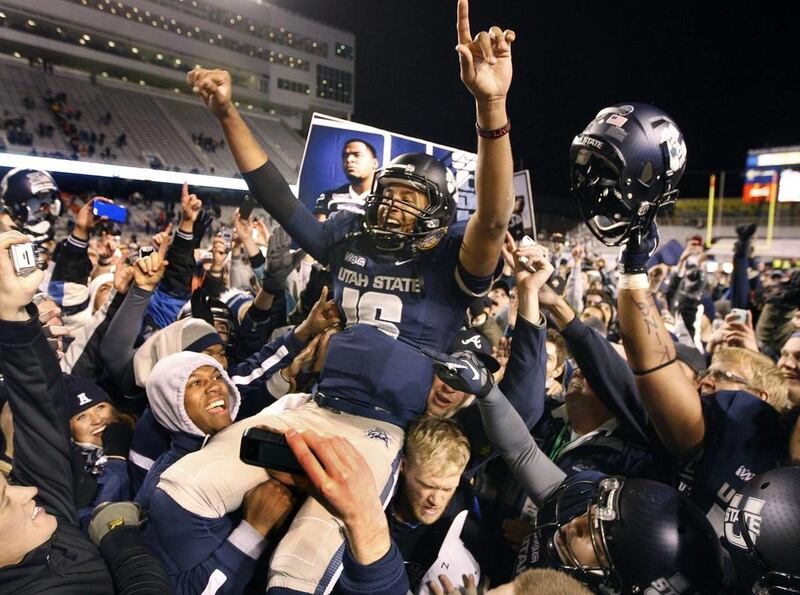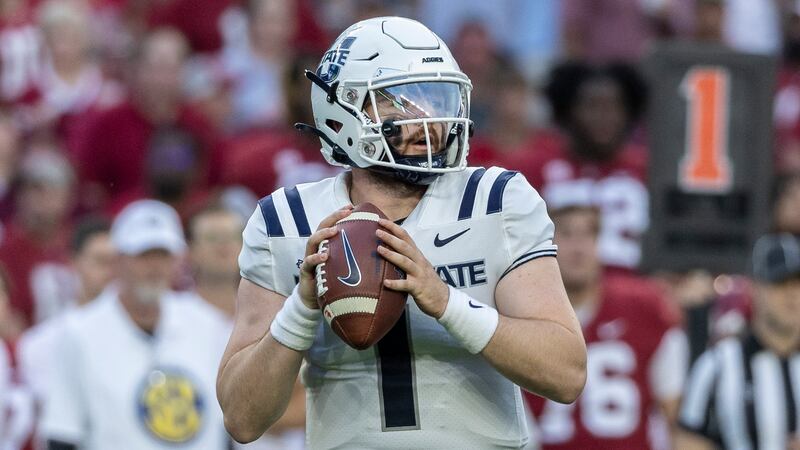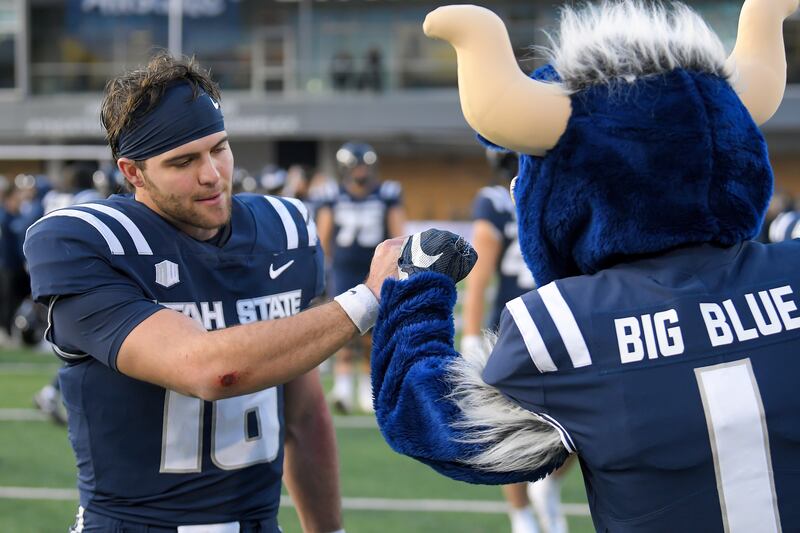Bryson Barnes is finally getting his shot at being the undisputed QB1 of a college football team this season.
The former Utah Ute turned Utah State Aggie has been a longtime backup during his career, albeit one who has seen considerable playing time due to injuries to the quarterbacks ahead of him on depth charts.
Entering his sixth season of college football, Barnes appears primed for a good year for the Aggies. Maybe, if things break right, a special one.
After all, in nine games played last year — including three starts — Barnes broke multiple USU program records, including most rushing yards in a game by a QB (193) and most consecutive 100-yard rushing games by a QB (two). All told, he accounted for nearly 1,400 yards of offense (1,386) and completed better than 60% of his pass attempts for 856 yards, 12 touchdowns and six interceptions.
Even with a new offensive coordinator (Kevin McGiven) and a new offensive attack that is on longer the all-gas, no-brakes variety, Barnes’ experience and track record of production could lead to something special.
Unless we are valuing experience too highly. Which begs the question — how have experienced QBs performed at Utah State? Has more playing time by the starting quarterback meant more production and wins for the Aggies?
Let’s take a look.
Since 2010, Utah State has had six senior QBs start the season as QB1.
They are:
- Diondre Borel (2010)
- Chuckie Keeton (2014 and 2015)
- Kent Myers (2017)
- Logan Bonner (2021 and 2022)
- Cooper Legas (2023)
- Spencer Petras (2024)
All six were various kinds of seniors.
Borel was a true senior, in his fourth season of college football. Keeton was a true senior and a fifth-year senior. Bonner was a sixth-year and seventh-year senior (he redshirted multiple seasons). Legas was a redshirt senior. Petras was a seventh-year senior.
Despite varying amounts of time in college, all six had played considerably in at least one season prior to being the Day 1 starter for the Aggies. They weren’t strangers to the bright lights of college football.
The results were fairly hit and miss, though.
Borel finished the 2010 season with 2,108 yards passing, eight touchdowns and 13 interceptions. He also rushed for nearly 300 yards and seven touchdowns. The Aggies won seven games with him leading the way, a three-game improvement on the year before, and the highest win total for USU in nearly 20 years.
Borel wasn’t a perfect QB, but context matters and in his senior season the Aggies were better than they’d been in a long time, for which he deserves a share of the credit.
Keeton, meanwhile, was an absolute superstar for Utah State the moment he arrived on campus as a true freshman in 2011. Injuries were a problem for the Aggie great, though, later in his career especially.

In his senior season in 2014, Keeton played in only three games before suffering a season-ending injury. He wasn’t off to the best start — through three games he averaged 142 yards passing per game and had thrown two touchdowns to four interceptions — and his injury forced the Aggies to go young with both Myers and Darell Garretson.
Of note, USU managed to win 10 games in 2014, led primarily by underclassmen at QB.
Keeton was back in 2015, but he missed five games in the middle of the season with a knee injury, and in a lot of ways was a shell of his former self. He threw for 1,006 yards, four touchdowns and seven interceptions in seven games played. USU took a serious step back, meanwhile, winning four fewer games than the year before.
Myers was a multi-year starter for the Aggies, who played a lot over the years with injuries to Keeton.
As a senior in 2017, it seemed that Myers was primed to lead the team and he played in 10 games, making seven starts. Myers finished the season with 1,278 passing yards, eight touchdowns and seven interceptions, but he was supplanted during the second half of the season by then redshirt-freshman Jordan Love, who would go on to become arguably the best QB in program history.
Utah State went 6-7 in 2017, winning three games with Myers as the starter.
Of all the senior QBs at Utah State the last 15 years, none was more successful than Bonner. At least in a single season.
A transfer from Arkansas State who’d previously redshirted his freshman year and then had a medical redshirt season, Bonner arrived in Logan with a wealth of experience as a starting QB.

He hit the ground running in Logan and had one of the best seasons in program history. An argument can be made it was the best, if you take into account the Mountain West Conference title USU won.
In 2021, Bonner threw for 3,628 yards, 36 touchdowns and 12 interceptions while leading the Aggies to an 11-3 record, a conference title and multiple wins over Power Five opponents.
Bonner was nothing short of spectacular in 2021, though he benefited from having two NFL receivers (Deven Thompkins and Derek Wright) to target.
An injury suffered in the LA Bowl put a little bit of a damper on Bonner’s success, but only a little.
The following year, however, Bonner was a far different player. Though it was insisted often that Bonner was healthy, recovered from the injury he suffered at the end of the previous season, he hardly looked it and struggled mightily in 2022.
Bonner ultimately played in only four games before injury took him out again, throwing for just 753 yards, six touchdowns and eight interceptions.
With him under center as QB1, USU went 1-3 to start the 2022 season, with dismal losses to Weber State and UNLV. Legas replaced Bonner and ultimately led the Aggies to a 6-6 regular-season record, but with a bowl loss the Aggies followed up their conference-title-winning season with a losing campaign.
Legas was QB1 to start the next season, in 2023. He started the first two games against Iowa and Idaho State, but was benched in favor of true freshman QB McCae Hillstead — now at BYU — during the Air Force game.
Injuries to Hillstead led to Legas being the starter again but the job wasn’t guaranteed to him until late in the year, and injuries then knocked Legas out, too.
Ultimately, he started seven of the nine games he played in 2023, and threw for 1,815 yards, 19 touchdowns and eight interceptions. And the Aggies, well they made it to a bowl game again, but finished the year with another 6-7 season.
Petras was by far the most experienced QB to suit up for the Aggies, maybe ever. He was a starter for Iowa for three consecutive seasons, spent an additional two years as a backup QB for the Hawkeyes and then was a student-coach working with QBs the year before he arrived in Logan.
He was the starting QB during arguably the most tumultuous season in USU history — again, context matters — which played a significant part in the Aggies’ 4-8 record.
Petras also dealt with multiple injuries — there’s a reason Barnes played in as many games as he did last season — but he managed to throw for 2,315 yards, 17 touchdowns, 11 interceptions.
Of the Aggies’ four wins in 2024, Petras was the starting QB for all four of them, though he didn’t finish wins against Robert Morris and San Diego State.
So how have experienced senior QBs fared at Utah State? Has experience under center led to more wins?
Not especially.
Outside of 2010 under Borel and 2021 under Bonner — notable seasons to be fair — having senior experienced QBs hasn’t meant special years for Utah State.
When the Aggies have been special it’s largely been because they’ve had special QBs under center, be it Keeton in 2012 or Love in 2018. There have been outliers, like 2014, though the Aggies were led that year by underclassmen at QB. Garretson might be the biggest what-if in the last 20 years for the Aggies.
Experienced quarterbacks may have fared better at Utah State if not for injuries. Injuries have been a real problem and upended seasons for Keeton and Bonner especially, though Legas and Petras both missed multiple games also because of injury.
Barnes has been fairly durable during his career, but no one is immune to getting banged up, him included. He was hospitalized in 2023 after a hit against Oregon State.
On paper, Barnes is close to the ideal quarterback for Utah State at this moment, with a new coaching staff, a new offense and two-thirds of the roster new to Utah State.
His dual-threat ability and his experience all appear to be a boon for the Aggies, who are quite unproven behind him with Jacob Conover, Anthony Garcia, CJ Tiller and Kaden Cox, who’ve combined to play in just nine games in college.
If precedence is any indication, though, Barnes will have a special season in 2025 because he’s a special QB. Or he won’t because he’s not. Experience at quarterback just hasn’t proven to be all that important in Logan.



